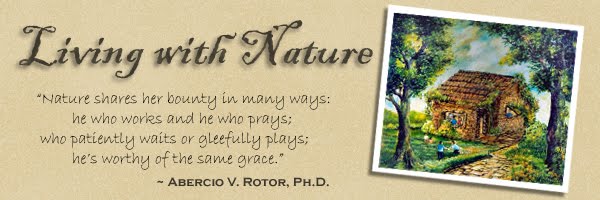Abe V Rotor
All
organisms, simple or complex, plant or animal – and human – are
governed by genes, which through the long process of evolution, are the
very tools for survival in Darwin’s treatise on Survival of the Fittest
through Natural Selection.
The
acquisition of successful genes is key to the survival of present day
species, and the explanation on the failure of those which did not. Two
words are important: adaptation and competition. This dual attributes
are directed to self-preservation through the process of acquiring the
basic necessities of life either by adjusting to it passively or
actively. Definitely it is not one that is easy to share to the extent
of losing its benefit in favor of another.
But
if we analyze it, this is true to each individual. Now organisms do
not live as individuals; they live as a community, as a society. Which
leads us to the logical inference that if the individual organism, in
order to survive must be selfish, then how can it be able to establish a
community in which it ultimately become a part?
This
is very important because the community is the key to resource sharing
from food to space; it is the key to collective bargaining in times of
peace or war. The community is like a bundle of individuals behaving
singularly. It is collective planting time when the monsoon arrives,
harvesting when it ends. The rituals that go with such activities
enhance the success of bonding, and enshrine it into an institution.
Institutions
were born from socio-economic needs which spontaneously developed into
cultural and political rolled into one complex society. To answer
where selfness starts is easier to answer than where selflessness
begins.
If the premise is biological what proofs can we show that it is so?
•
Social insects – ants, bees and termites – bind themselves as a
colony. Any attack on the colony sends soldiers to fight the enemy.
Paper wasps sting as intruders. The honeybee does not consume the
nectar and pollen it gathers, but brings the harvest into the granary
from which it get its share later. An ant clings to death at an enemy.
When a bee sting, its abdomen is ripped away and is surely to die.
•
Starve an aphid or a mealybug, and it will produce young prematurely –
even without first becoming an adult. This is called paedogenesis. Or
an adult may produce young without the benefit of mating and
fertilization. This is parthenogenesis.
•
A plant stressed by drought will cut its life cycle short in order to
use the remaining energy to produce offspring. This is true to
grasshoppers or caterpillars – they skip one or two moulting and
metamorphose so that they can mate and reproduce.
•
The spacing of plants is determined not only of soil and climatic
conditions that control the growth and development, but by a biological
mechanism known as allelopathy. A date palm will kill its own
offspring around its trunk and under its crown. Those that grow outside
its shadow becomes a part of the oasis’ vegetation.
•
Bacteria, yeasts, and other microorganisms go into luxury feeding
where there is plenty, and nature seems not to mind, until they consume
the food, and worse until their waste accumulates and becomes toxic.
This is called autotoxicity. Thus in fermentation, it is the toxic
material - alcohol - that eventually kills the yeasts themselves, and
another process follows until the organic forms of compounds are
transformed and ultimately returned as inorganic ready for use by
succeeding organisms.
•
The dalag or mudfish and many other species of fish eat their young leaving only
those that can escape. Here the advantage of controlled population and
survival of the fittest are shown.
•
Vultures seldom attack a living prey; they wait to its last breath. A
male lion will kill a cub which it did not sire. But we know too, that
there are surrogate mothers in the wild like the cuckoo, and among
domestic animals.
Because
of the complexity of social behavior, Dr E O Wilson of Harvard
University, attempted to explain many of the observed behavior into a
field of biology he called sociobiology. In a simple illustration, if
your child is about to be hit by a fast oncoming vehicle, a mother
would risk her life to save him. Dr. Wilson would then asks a third
party if he or she would do the same thing to a child who is not his
own – much less without any relations.
This leads us back to our previous question: When does selfishness end and selflessness begin?~


No comments:
Post a Comment